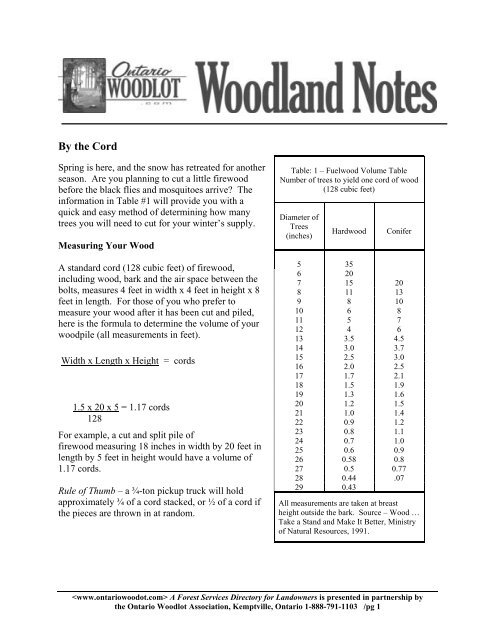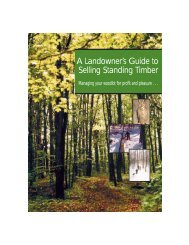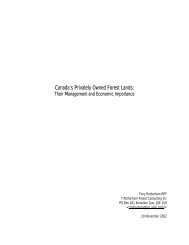By the Cord - Ontario woodlot.com
By the Cord - Ontario woodlot.com
By the Cord - Ontario woodlot.com
You also want an ePaper? Increase the reach of your titles
YUMPU automatically turns print PDFs into web optimized ePapers that Google loves.
<strong>By</strong> <strong>the</strong> <strong>Cord</strong><br />
Spring is here, and <strong>the</strong> snow has retreated for ano<strong>the</strong>r<br />
season. Are you planning to cut a little firewood<br />
before <strong>the</strong> black flies and mosquitoes arrive? The<br />
information in Table #1 will provide you with a<br />
quick and easy method of determining how many<br />
trees you will need to cut for your winter’s supply.<br />
Measuring Your Wood<br />
A standard cord (128 cubic feet) of firewood,<br />
including wood, bark and <strong>the</strong> air space between <strong>the</strong><br />
bolts, measures 4 feet in width x 4 feet in height x 8<br />
feet in length. For those of you who prefer to<br />
measure your wood after it has been cut and piled,<br />
here is <strong>the</strong> formula to determine <strong>the</strong> volume of your<br />
woodpile (all measurements in feet).<br />
Width x Length x Height = cords<br />
1.5 x 20 x 5 = 1.17 cords<br />
128<br />
For example, a cut and split pile of<br />
firewood measuring 18 inches in width by 20 feet in<br />
length by 5 feet in height would have a volume of<br />
1.17 cords.<br />
Rule of Thumb – a ¾-ton pickup truck will hold<br />
approximately ¾ of a cord stacked, or ½ of a cord if<br />
<strong>the</strong> pieces are thrown in at random.<br />
Table: 1 – Fuelwood Volume Table<br />
Number of trees to yield one cord of wood<br />
(128 cubic feet)<br />
Diameter of<br />
Trees<br />
(inches)<br />
Hardwood<br />
Conifer<br />
5 35<br />
6 20<br />
7 15 20<br />
8 11 13<br />
9 8 10<br />
10 6 8<br />
11 5 7<br />
12 4 6<br />
13 3.5 4.5<br />
14 3.0 3.7<br />
15 2.5 3.0<br />
16 2.0 2.5<br />
17 1.7 2.1<br />
18 1.5 1.9<br />
19 1.3 1.6<br />
20 1.2 1.5<br />
21 1.0 1.4<br />
22 0.9 1.2<br />
23 0.8 1.1<br />
24 0.7 1.0<br />
25 0.6 0.9<br />
26 0.58 0.8<br />
27 0.5 0.77<br />
28 0.44 .07<br />
29 0.43<br />
All measurements are taken at breast<br />
height outside <strong>the</strong> bark. Source – Wood …<br />
Take a Stand and Make It Better, Ministry<br />
of Natural Resources, 1991.<br />
A Forest Services Directory for Landowners is presented in partnership by<br />
<strong>the</strong> <strong>Ontario</strong> Woodlot Association, Kemptville, <strong>Ontario</strong> 1-888-791-1103 /pg 1
Heating Value<br />
Different tree species provide for different quality of fuelwood. While certain species may be<br />
easier to split and are more readily available, <strong>the</strong>re are two main factors you should consider<br />
when cutting or buying your winter’s fuelwood.<br />
Moisture content – seasoned air-dried wood contains approximately 20% moisture and will yield<br />
about 13,000 BTUs per kilogram. Green wood<br />
containing approximately 60% moisture content will<br />
yield about 9,200 BTUs per kilogram. <strong>By</strong> cutting your<br />
fuelwood a year in advance, you will be burning dry<br />
wood and will increase your heating value by 30%.<br />
Burning dry wood will also reduce <strong>the</strong> amount of<br />
creosol buildup in your chimney.<br />
Species – a second and more important factor in<br />
determining <strong>the</strong> heating value of wood is its density.<br />
This varies according to species. Table #2 shows <strong>the</strong><br />
gross heating value of one cubic metre for <strong>the</strong> various<br />
native species found in <strong>Ontario</strong>.<br />
Wood Burning and Global Warming<br />
Wood differs from fossil fuels such as oil and gas<br />
because it is a renewable resource. As a tree grows, it<br />
absorbs carbon dioxide from <strong>the</strong> air and stores it in <strong>the</strong><br />
wood as carbon. This carbon makes up approximately<br />
half of <strong>the</strong> weight of wood. When wood is burned,<br />
carbon dioxide is released again into <strong>the</strong> atmosphere.<br />
The same amount of carbon dioxide would be released<br />
if <strong>the</strong> tree died and were left to rot on <strong>the</strong> forest floor.<br />
Your <strong>woodlot</strong> can be a continuous source of fuel<br />
provided it is cared for and managed properly.<br />
For more information on burning wood for heat, you<br />
may want to obtain a copy of <strong>the</strong> following guide:<br />
A Guide to Residential Wood Heating. Natural<br />
Resources Canada and Canada Mortgage and Housing<br />
Corporation. ISBN 0-662-21085-9. Fax (819) 994-1498.<br />
© 2003, <strong>Ontario</strong> Woodlot Association<br />
Table: 2 – Heating Value of <strong>Ontario</strong> Tree<br />
Species<br />
Species<br />
Gross Heating Value<br />
(million BTU) *<br />
Rock Elm<br />
Shagbark Hickory<br />
32.0<br />
30.6<br />
White Oak 30.6<br />
Sugar Maple 29.0<br />
Beech 27.8<br />
Red Oak 27.3<br />
Yellow Birch 26.2<br />
White Ash 25.0<br />
White Elm 24.5<br />
Red Maple 24.0<br />
Tamarack 24.0<br />
Black Cherry 23.5<br />
White Birch 23.4<br />
Hemlock 17.9<br />
Trembling Aspen 17.7<br />
White Pine 17.1<br />
Basswood 17.0<br />
White Cedar 16.3<br />
White Spruce<br />
Balsam Fir<br />
16.2<br />
15.5<br />
* BTU value based on an air-dry cord of<br />
wood.<br />
A Forest Services Directory for Landowners is presented in partnership by<br />
<strong>the</strong> <strong>Ontario</strong> Woodlot Association, Kemptville, <strong>Ontario</strong> 1-888-791-1103 /pg 2

















